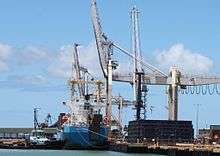Port of Townsville
| Port of Townsville | |
|---|---|
 | |
| Location | |
| Country | Australia |
| Location | Townsville, Queensland |
| Details | |
| Opened | 1863 |
| Operated by | Port of Townsville Limited |
| Owned by | Queensland Government |
| Available berths | 8 |
| Wharfs | 8 |
| Employees | 100 |
| Chief Executive | Ranee Crosby |
| Chair | Renita Garard |
| Statistics | |
| Annual cargo tonnage | 11,020,000 |
| Annual container volume | 59,000 |
| Value of cargo | $11 billion |
|
Website www | |
Port of Townsville is a government-owned Corporation and seaport in Townsville, Queensland, Australia. It is the third largest seaport in Queensland after Port of Brisbane and the Central Queensland Port in Gladstone. It is located south of the mouth of Ross Creek and north of the Ross River. A second seaport, which only exports sugar is found about 100 kilometres (62 mi) north of Townsville at Lucinda and is also managed by Port of Townsville Limited.[1]
The Port of Townsville is intrinsically linked to the sustainability of the North Queensland economy, and during 2014/2015 handled $11 billion in trade. More than 30 different commodity types are imported and exported through Townsville including mineral ores, fertiliser, concentrates, sugar and motor vehicles. Townsville is the number one port in Australia for exports in copper, zinc, lead and sugar.
In 2014, just under 250,000 head of live cattle were shipped from the Port of Townsville, making it the second largest live export port in Australia after Darwin.[2]
The Port of Townsville's Berth 10 was specifically designed to accommodate the Royal Australian Navy's new LHD vessels, HMAS Adelaide and HMAS Canberra and the port also accommodates US Navy on rest and recuperation in Townsville.
History


The establishment of the Townsville port site in 1864 was made to serve the hinterland pastoral properties that provided the impetus for the birth of Townsville. A wharf was first constructed at the location in 1864 and the port was officially anointed by the government on 31 September 1865 when Townsville was gazetted as a Port of Entry. 1874 saw the construction of the first breakwater. In 1896, Cyclone Sigma struck Townsville causing significant damage to the port and leading to the formation of the Harbour Board.[3]
In 1906, gas lighting was installed at the Port of Townsville. During the 1920s wool was the dominant export, changing to coal and ore in the 1930s. In WWI more than one million tonnes of war supplies and 300,000 tonnes of fuel passed through the Townsville port. In 1959, the bulk sugar terminal opened, only to burn down four years later in 1963 in a fire that raged for three days. The shed was quickly rebuilt that same year.
In 1967, reclamation works of an additional 170 acres provided space for expansion and the construction of oil facilities, development of prawn and fish processing works, an LPG terminal and bulk steel store. In 1969, the first roll on/roll off vessels arrived with imported containers and vehicles. In 1974, the first export of nickel ore took place. In 1980, the reclamantion of another 9.1 hectares adjacent to the eastern breakwater allowed for a new container terminal, LPG terminals and an aqua amonia terminal. During the 1980s a new eastern breakwater was built and the commercial fishing fleet was moved to Ross Creek. In 1997, BHP built Berth 11 to handle mineral concentrates from the Cannington Mine. In 2013, the $85 million project upgrade Berth 10 and construct Quayside Terminal was completed.
In July 2010, the port shipped the first iron ore to depart from the East Coast of Australia since the 1800s.[4] In August 2012, it was reported that the port was operating at about one third of its capacity.[5]
Expansion
The Townsville port recently underwent an expansion in the Inner Harbour including the $85 million upgrade of Berth 10 (and construction of Quayside Terminal for cruise ships) as well as an $85 million upgrade of Berth 8. A project to upgrade Berth 4, valued at $55 million, is currently underway and due for completion at the end of 2017.
See also
References
- ↑ "Port of Townsville Limited". Department of Transport and Main Roads. 7 June 2012. Retrieved 9 August 2012.
- ↑ "Cattle Statistics". LiveCorp. Retrieved 19 October 2015.
- ↑ History of Townsville Meteorological Office. Commonwealth of Australia. Retrieved 8 February 2016.
- ↑ Josh Bavas (13 July 2010). "Iron ore shipment leaves Townsville port". ABC News. Australian Broadcasting Corporation. Retrieved 9 August 2012.
- ↑ Charlie McKillop (8 August 2012). "No beef with Townsville port, but regional mayors demand change". ABC Rural. Australian Broadcasting Corporation. Retrieved 9 August 2012.
External links
| Wikimedia Commons has media related to Port of Townsville. |
Coordinates: 19°14′56.75″S 146°50′11.81″E / 19.2490972°S 146.8366139°E